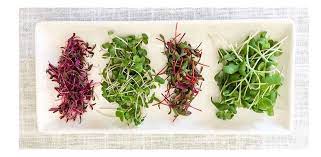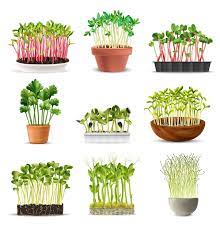Introduction
Microgreens offer a delightful journey into the world of flavors, colors, and textures. These tiny, nutrient-packed greens are not only visually appealing but also incredibly versatile. To elevate your culinary experience, it’s essential to experiment with different microgreen varieties and flavors. In this blog, we’ll explore how to unleash your creativity and enhance your dishes by incorporating a diverse range of microgreens.
Why Experiment with Microgreens?
Diverse Flavors: Microgreens span the flavor spectrum, from mild and nutty to peppery and tangy. Experimenting with different varieties can add depth and complexity to your dishes.
Vivid Colors: Microgreens come in a rainbow of colors, providing both visual appeal and opportunities for creative plating.
Nutritional Variety: Different microgreens offer distinct nutritional benefits. By experimenting with a variety of types, you can ensure a broader range of vitamins and minerals in your diet.
Texture Play: Microgreens not only add flavor but also contribute to the texture of your dishes. Some microgreens offer crispness, while others are delicate and tender.
How to Experiment with Microgreen Varieties and Flavors:
Start with the Basics:
Begin by growing and tasting the foundational microgreens. These include:
Radish Microgreens: These pack a peppery punch and add a burst of flavor to sandwiches, salads, and wraps.
Sunflower Microgreens: With a mild, nutty taste, they are versatile and work well in various dishes.
Pea Shoots: Delicate and slightly sweet, they are perfect for enhancing salads, soups, and stir-fries.
Mix and Match:
Combining different microgreens can elevate your culinary creations. For instance:
Create a mix of mild and spicy varieties to balance flavors.
Experiment with a mix of colors for visually stunning dishes.
Combine microgreens with herbs like basil or cilantro for an aromatic twist.
Pairing with Cuisine:
Think about the type of cuisine you’re preparing. Different microgreens can complement various dishes:
Italian Cuisine: Basil microgreens add an aromatic and peppery kick to pasta, pizza, and caprese salads.
Asian Cuisine: Cilantro microgreens are a natural fit for sushi, noodle bowls, and stir-fries.
Mediterranean Cuisine: Enhance your Greek salads with arugula microgreens for a peppery touch.
Experiment with Bold Flavors:
Microgreens like mustard and arugula pack a punch. Try them with foods that can handle their spiciness, like spicy tacos or hearty sandwiches.
Garnish Creatively:
Elevate your dishes with microgreen garnishes. Try using:
Cilantro or basil microgreens to top off Thai or Indian curries.
Pea shoots for a fresh and vibrant finish on creamy soups.
Radish or mustard microgreens to give a kick to your burgers.
Harvest Maturity:
Microgreens are harvested at different stages, and each stage offers unique flavors. Experiment with early cuts for a milder taste and later cuts for intensified flavors.
Keep a Microgreen Journal:
Document your experiments in a journal. Note the varieties you’ve tried, how you’ve used them, and your preferences. This will help you remember what worked best for each dish.
Conclusion
Experimenting with different microgreen varieties and flavors is a culinary adventure that promises delightful and unique experiences in every meal. From subtle sweetness to fiery spiciness, there’s a microgreen for every palate and dish. Embrace your inner chef and embark on a journey of creative and flavorful experimentation with these nutrient-packed wonders. Happy microgreen adventures!




